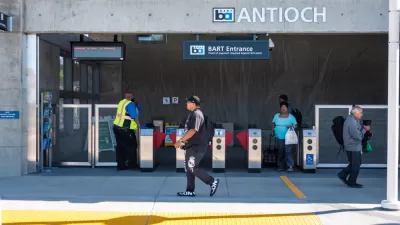California's high-speed rail project is in fact going to be built despite the state's looming budget crisis, but many are beginning to question what kind of impact the project will have if the right development around train stations is not met.
Being cash-strapped, however, leaves little room for the state to focus on transit-oriented development, which many believe would be a key to it's success. Experts cite what is referred to as the BART syndrome, where Bay Area Rapid Transit stations are often left without high-density development in close range, thus making little impact in reducing sprawl and car use.
According to Gabriel Metcalf of the San Francisco Planning and Urban Research Association, "the environmental benefits of rail will be lost if there isn't development around the stations, which are currently planned for both dense urban centers [Los Angeles and San Francisco] and more sprawling cities like Gilroy, Fresno and Bakersfield."
Thanks to Shay Kahen
FULL STORY: Will High-Speed Rail Get Sick with BART Syndrome?

Planetizen Federal Action Tracker
A weekly monitor of how Trump’s orders and actions are impacting planners and planning in America.

Restaurant Patios Were a Pandemic Win — Why Were They so Hard to Keep?
Social distancing requirements and changes in travel patterns prompted cities to pilot new uses for street and sidewalk space. Then it got complicated.

Maui's Vacation Rental Debate Turns Ugly
Verbal attacks, misinformation campaigns and fistfights plague a high-stakes debate to convert thousands of vacation rentals into long-term housing.

In California Battle of Housing vs. Environment, Housing Just Won
A new state law significantly limits the power of CEQA, an environmental review law that served as a powerful tool for blocking new development.

Boulder Eliminates Parking Minimums Citywide
Officials estimate the cost of building a single underground parking space at up to $100,000.

Orange County, Florida Adopts Largest US “Sprawl Repair” Code
The ‘Orange Code’ seeks to rectify decades of sprawl-inducing, car-oriented development.
Urban Design for Planners 1: Software Tools
This six-course series explores essential urban design concepts using open source software and equips planners with the tools they need to participate fully in the urban design process.
Planning for Universal Design
Learn the tools for implementing Universal Design in planning regulations.
Heyer Gruel & Associates PA
JM Goldson LLC
Custer County Colorado
City of Camden Redevelopment Agency
City of Astoria
Transportation Research & Education Center (TREC) at Portland State University
Jefferson Parish Government
Camden Redevelopment Agency
City of Claremont





























